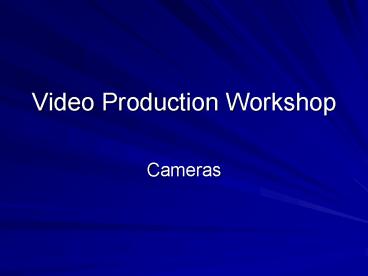Video Production Workshop - PowerPoint PPT Presentation
1 / 24
Title:
Video Production Workshop
Description:
Video Production Workshop Cameras Questions? Write down three things you want to learn. Six Steps to Video Production Concept Development Pre - Production ... – PowerPoint PPT presentation
Number of Views:165
Avg rating:3.0/5.0
Title: Video Production Workshop
1
Video Production Workshop
- Cameras
2
Questions?
- Write down three things you want to learn.
3
Six Steps to Video Production
- Concept
- Development
- Pre - Production
- Production
- Post Production
- Review
4
Step 1 Concept
- The controlling idea or theme of a production.
- The working title of a project.
- What is my story about?
- Ten words or less.
5
Step 2 Development
- Research and gather information
- Schedule interviews and shoot dates
- Create an outline
- Brainstorm production ideas
6
Step 3 Pre - Production
- Check all equipment
- Gather all photos or graphics
- Finalize game plan
- More time spent on these first steps, the better
the outcome.
7
Step 4 Production
- Good Sound, Good Video
- Arrive early
- Use a tripod
- Make every shot count
- B-roll
- Double check audio settings
- Wear headphones during interviews
- Good Sound, Good Video
8
White Balance
- White balance (WB) is the process of removing
unrealistic color casts, so that objects which
appear white in person are rendered white in your
video. - In other words No blue video
- Zoom in on something white and press AWB button
9
Iris
- The amount of light entering the lens
- Iris up when dark
- Iris down when bright
- CAUTION Do not trust auto Iris
- Use your Gain in very dark situations
10
Tripod
- The cameras best friend
- When do I use a tripod?
- Attaching a camera to the tripod
- Remember steady shots good video
11
Sequencing
- Foundation of video storytelling
- Wide, Medium, Tight
- Compress time in a video story
- Anticipate the action
- Wheres the action headed
- Shoot the action then reaction
12
Rule of Thirds
- The most important elements are placed where
these lines intersect.
13
Rule of Thirds
- Avoid placing subjects in that middle square, and
you have followed the rule of thirds.
14
Just Say No Zooms and Pans
- Zooms and Pans Lazy Production
- Practice Wide, Medium and Tight shots.
- No one wants to be sick when watching your video.
15
Lighting
- 3 point lighting
- Key Light
- Fill
- Back Light
16
Key light
- Main light
- Strongest and has the most influence
- Placed to one side of the camera
17
Fill
- Secondary light, opposite side of key light
- Fills the shadows created by the key
- Less bright than the key.
18
Back Light
- Placed behind the subject
- Provides definition and subtle highlights
- Helps separate the subject from the background
19
Interviews
- Names and titles
- Arrive early
- Be prepared with 5 good questions
- Ask why or how come when given one word
answers. - Conduct interviews first if possible
20
Microphones
- Lapels
- Handheld Stick
- Shotgun
21
What Mic do I use, when?
- Lapels always used for news show anchors,
sit-down interviews. - Handheld Stick On the spot
- Shotgun attached to camera for nat sound
22
B-Roll
- Get enough
- Set your shots, then record.
- Shoot away from windows
- Wide, Medium, Tight sequences
- Nat sound
- No Zoom
- Shoot what was mentioned in interview
23
Step 5 Post - Production
- Label your tapes
- Watch your video and log
- Write your story
- A-Roll all audio portions of story
- B-Roll over voice over portions
- Review project
24
Review
- Feedback and critique
- The whole class should participate
- Have students watch classmate reactions
- Take notes






























